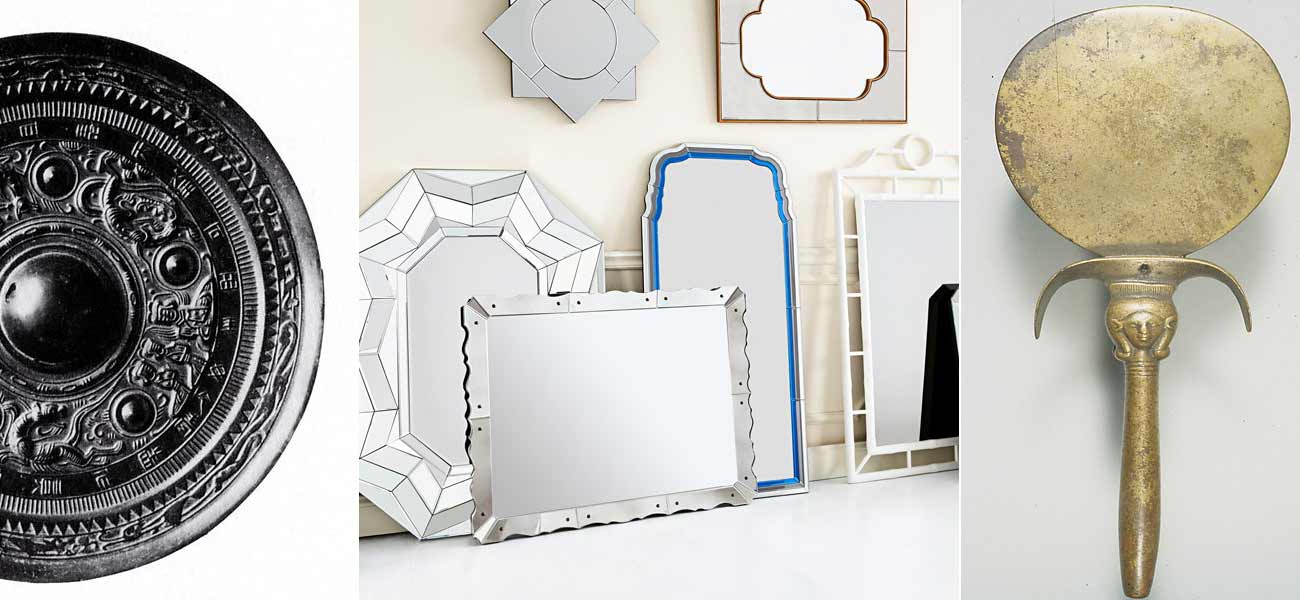“LARGE MIRRORS WERE ASSOCIATED WITH A CERTAIN IDEA OF LIFE, A TASTE FOR SPLENDOR AND PERFORMANCE THAT ONLY CERTAIN CLASSES AND PROFESSIONS COULD ENJOY. THEY WERE A HALLMARK OF SOCIAL STANDING, AND ALL BEAUTIFUL HOUSES HAD TO HAVE THEM.”
SABINE MELCHIOR-BONNET--THE MIRROR: A HISTORY
Next time you catch your reflection in the mirror, let the pleasure of daily life heighten knowing that what you see is much more than you. Mirrors are central to every aspect of human history—art, archaeology, medicine, psychology, philosophy, technology, optics—and of course, style. They are a technology wrapped in notions of beauty, love and eros...where luxury still matters.
Sure, it’s you in the mirror. But, the history of mirrors reaches back centuries to when mirrors were rare objects, thought to be endowed with magical powers and literally…worth their weight in gold. Today, glass and mirrors link directly to modernity through photographs, selfies and screens. Indeed, since discovery, mirrors have been integral to the leading technologies of the day and any contemporary construction of self.
“Large mirrors were associated with a certain idea of life, a taste for splendor and performance that only certain classes and professions could enjoy. They were a hallmark of social standing, and all beautiful houses had to have them.” Sabine Melchior-Bonnet--The Mirror: A History
It is likely that the first humans saw their reflections in still waters and, for a sociological basket of reasons, wanted more. Mirror is a Latin verb that means, “to admire”. Until 1835, mirrors had such high costs that only one-percenters could check how they looked going out the door. In Renaissance Italy, a mirror cost three times more than a Raphael portrait. Another data point says a medium sized mirror was comparable in price to that of a fine country home.
Today we are so accustomed to encountering our image it is difficult to measure the sensation of seeing yourself in a mirror for the first time. The impact on self-image and human sensibilities in general would have been life changing.
Take yourself back to a when you were a child and seeing what you looked like was new. The things we live our lives in often have secret histories. Knowledge enriches a purchase and, we hope, brings enormous pleasure.
HISTORICAL CHRONOLOGY OF MIRRORS: HOW HUMAN REFLECTION CHANGED CULTURE AND SOCIETY
There were cautions from the start. Socrates hoped people would learn from what they saw in the mirror. The church suspected mirrors had magical powers and associated the personal image with sin. Catholics warned against vanity, lasciviousness and other deadly transgressions. With strong forces both for and against the usage of mirrors, how could they not embody the development of self-consciousness and changing notions of self-knowledge. What would happen when people had access to their own image? Today, we know the answers because they're all around us.
“Ardently coveted, but no larger than a dinner plate, the mirror was for a long time a symbol of aristocratic luxury, a means of maintaining appearance. Situated at the crossroads of nature and culture, it educated the eye and assisted in relaying lessons in civility. From a glance in the mirror flowed not only a taste for ornament and an attention to social display and hierarchy, but also a new geography of the body, which made visible previously unfamiliar images (one’s back and profile) and stirred up sensations of modesty and self-consciousness." Sabine Melchior-Bonnet--The Mirror: A History




TECHNOLOGICAL CHANGES IN MIRROR MAKING
Mirrors are hard to make. There is glass technology. Then, there are issues involved in reflectivity coatings and changing tastes. Let’s characterize the issues as stability, clarity, size, price and image trueness. Each posed unique challenges, which were solved incrementally over hundreds of years. It is only recently that large panes of uniform, thin, untinted glass are available at affordable prices.
GENERAL CHRONOLOGY OF TECHNICAL CHANGES TO GLASS PRODUCTION AND WHAT THESE INNOVATIONS MEANT FOR THE DISPERSION AND USAGE OF GLASS MIRRORS
MIRRORS APPEAR IN SYRIA, 500 AD
The first real glass mirrors of antiquity were from the Syrian cradle of civilization around 500 AD. The change is marked by the creation of clearer, truer reflective glass mirrors using poisonous silver-mercury amalgams in a process similar to that of making glass tiles. The process saw two layers of hot glass slumped into cast lead forms with a thin layer of molten or polished metal sheeting in between.
Another method blew a thin sphere of glass and filled it with hot lead, then cut away the extra. Both methods yielded mirrors that were always slightly toned and gently curved, which means the reflections were dim and imprecise. That said, these early methods yielded mirrors with truer reflections than polished metal discs, for which mirrors were the better substitute. The new technology spreadthroughout the Roman Empire rapidly.
THE MIDDLE AGES: 476 AD TO 1500
The west was in the dark ages and mirror making was largely lost. These were very superstitious times when reflected images were suspected of being devilish. Up through the 10th century glassmakers were more successful at producing colored glass and jewelry stones than clear glass.
Sometime in the 1100s, mirror makers began to measurably improve their craft, which flourished in Venice of the 1200s. Venice innovated a straw-blown cylindrical “sleeve” of glass. When artisans cut off the ends and flattened the cylinder sleeve, it yielded a relatively flat piece of glass, which could be spliced together and made suitable for windows or mirrors.
THE GOLDEN AGE OF GLASSMAKING IN VENICE, ITALY
In 1291 Venice moved its glassmaking facilities to the island of Murano because the glass kilns kept catching on fire in town and burning down neighborhoods. The other reason for the move was to isolate glassmakers and protect the trade secrets they held.
Meanwhile, Venetian guildsmen were perfecting mirror making. From 1292 until 1665, Venice is the main glass provider to the rest of Europe with a monopoly on luxury, artisan glass. Luxury industries were so important to Venice that sharing trade secrets about glassmaking or silk weaving was punishable by death.
Venetian experiments with still toxic mercury glass (amalgams of glass, mercury and tin) pushed creativity outside the looking glass. Ebulliently ornate frames and beveled edges were unique to Venetian skills and highly prized by fashionable people everywhere.



VENICE: THE SILK ROUTE'S END
Venice is located at the end of the silk route. Yes, that one. Strange to think about this tiny, fragile, perfect place as being the west’s military hegemon (a role filled by today’s USA). But, it was.
My Venetian history professor said every bit of spice, luxury and sin that came over the Silk Road from Asia was financed, protected and taxed to pay for the storybook city of today. For a magical 150 years, Venice was the richest city, with the most powerful navy, in the world. At the apex of power, Venice conquered half of Istanbul and far into what is today’s Greece.
OPTICALLY CLEAR MIRRORED GLASS IN VENICE
Around 1350 Venetians began grinding quartz pebbles into silica sand, which was a huge improvement in clarity and image quality. A Venetian guild of mirror makers formed around 1373 to codify these improvements. From the 1450s, glassmakers in Murano knew how to make a glass so pure, white and fine that they called it “Cristallo” because of similarities to rock crystal, which it resembled.
“Venetians realized that the ashes of kali, an herb that they brought back from Egypt by boat, when mixed with a certain quantity of sand, acted as a bleaching agent because of its low phosphorous content and high manganese content. Thus, they obtained a molten glass that was especially white.” Sabine Melchior-Bonnet--The Mirror: A History
Around 1500, Venetians learned to pour clear glass into small, flat sheets that could then be backed with silver leaf or lead. They also learned to blow glass of extreme thinness.
Venetians failed at innovating their way to mirrors of very large sizes, rarely surpassing the format and dimensions of its tray-sized mirrors, pictured here. Quality improvements elsewhere and the lower prices of competitors caused the Italian industry to collapse around 1685 when confronted by competition from France and Bohemia. For the Venetian glass industry, the 1700s began gangbusters and ended in what the Venetians called a “crisis”.
MIRROR MAKING IN FRANCE
Before 1630 mirrors were still rare in France. Between 1638 and 1648 possession expanded to one mirror in every three Parisian households. From then mirrors were still expensive but the popularity would reach all social classes. After 1650 mirrors would be found in two out of three urban French households.
The market for mirrors looked so promising, France wanted in. In 1665 Louis XIV established la Manufacture des Glaces at (at the Saint-Gobain factory) by royal initiative. Adding France to the global supply greatly expanded the production of mirrors.
In 1678 three Murano glassmakers were bribed to reveal Venetian mirror making secrets, which effectively dissolved the Murano monopoly. The same year, Frenchie Bernard Perrot figured out how to make larger sheets of mirror glass. Four years later, these innovations created the still sensational Hall of Mirrors at Versailles with 17 arches clad in 357 mirrors reflecting 17 identical arcade windows. Each arch contains 21 mirrors. Meant to glorify France, it is perhaps the most recognized interior in the world and one of the most beautiful achievements of French culture.
Around 1700 the technical advances at Saint-Gobain gave France the upper hand to produce panes of glass greater than seventy inches tall, the maximum size attainable by glass-blowing. Prices dropped. French glass could be sold for one quarter of what Venice charged, completing the Venetian demise.
FRENCH SOCIETY WAS RULED BY HIERARCHICAL PRECEDENCE
Starting in 1701, the pervasive use of mirrors in French interior architecture made them an instrument of social rules and relationships. By capturing the reflection of French society, the mirror, in effect, documented life at court. Consequently, the use of pier mirrors and mirrored overmantles became a defining feature of French-style apartments.
VENETIAN DEMISE
When Napoleon closed the glass factories in 1807, little was left of the skills that had sustained Venice for two centuries as the undisputed leader in the production of fine glass. The downward swoon quickened in 1835 when German chemist Justus von Liebig developed a silvered glass mirror. Silvered-glass mirror used a type of silver nitrate to place a thin layer of real silver ore onto the glass replacing toxic mercury glass.
Together, these innovations enabled mirrors to be manufactured on a much larger scale. The diffusion of mirrors to larger groups of people was driven by social class and contact with big cities up until WWI when the appearance of magazines became the big driver of demand. For the first time in history ordinary people could buy a mirror. The most recent innovation is that present-day mirrors are more frequently produced by depositing aluminum film by vacuum directly onto the glass. For tips on how to use mirrors, go here.
KEY DATES FOR THE DEVELOPMENT OF GLASS AND MIRRORS IN EUROPE
- 500 AD Mirrors appear in Syria
- 476-1200s Mirror technology did not develop during the Middle Ages in the west because of religious prohibitions.
- 1100s to 1300s Glass and mirror making methods improved in Venice, Italy.
- 1291 Venice moved their glass making kilns to Murano coinciding with Venice becoming the premiere exporter of luxury glass and mirrored glass to the rest of Europe until 1635.
- 1350 Venetians started using silica, which produced very clear, “Cristallo” glass.
- 1500 Venetians learned to pour clear glass into flat sheets, which created larger panes of glass.
- 1650 Mirrors could be found in two out of three urban French households.
- 1665 France founded the royally warranted Saint-Gobains glass factory.
- 1678 French innovation discovered how to make very large panes of glass and construction begins on Versailles’s Hall of Mirrors.
- 1685 Competition from lower priced competitors caused the Venetian glass industry to decline.
- 1700 France could make mirrors 70 inches tall, the largest available at the time. The innovation helped French glass become the best value. It sold for 25% of what Venice charged.
- 1807 Napoleon closed the Venetian glass factories as part of his victory.
- 1835 A German chemist developed less toxic silvering process.
Quotes: Sabine Melchior-Bonnet, The Mirror: A History, (Routledge, 2002).
Venice facts: Corning Museum of Glass http://blog.cmog.org/
Photos: © Bungalow 5, LLC
Photos: © The Metropolitan Museum of Art
Photos: © Christies, Blue Venetian Glass
Photos: © Christies, Clear Venetian Glass






